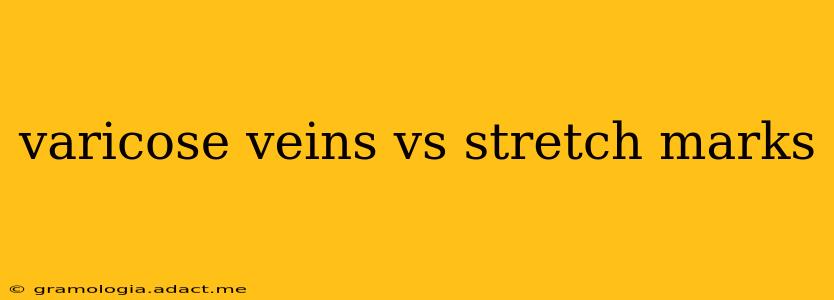Varicose veins and stretch marks are both common skin conditions, but they are vastly different in their causes, appearance, and treatment. Understanding their distinctions is crucial for proper diagnosis and effective management. This comprehensive guide will explore the key differences between varicose veins and stretch marks, answering common questions and providing valuable insights into each condition.
What are Varicose Veins?
Varicose veins are swollen, twisted veins that appear most often in the legs and feet. They develop when the valves inside the veins weaken, causing blood to pool and increase pressure within the vessels. This pooling of blood causes the veins to enlarge and become visible beneath the skin's surface. They often appear as blue or purple, bulging, rope-like structures.
Several factors contribute to the development of varicose veins, including genetics, aging, prolonged standing or sitting, pregnancy, and obesity. While often a cosmetic concern, varicose veins can sometimes cause aching, throbbing pain, swelling, and itching.
What are Stretch Marks (Striae)?
Stretch marks, also known as striae, are streaks or lines that appear on the skin when it stretches or shrinks rapidly. This rapid change in skin elasticity can lead to the breakdown of collagen and elastin fibers, resulting in the characteristic indented lines. These marks are most commonly found on the abdomen, thighs, breasts, and buttocks.
Stretch marks initially appear red or purple but gradually fade to a silvery-white or pale color over time. They are generally harmless, although some individuals may experience itching or discomfort. The development of stretch marks is often associated with rapid weight gain or loss, pregnancy, puberty, and certain medical conditions like Cushing's syndrome.
What is the Difference in Appearance Between Varicose Veins and Stretch Marks?
The visual distinction between varicose veins and stretch marks is quite clear. Varicose veins are raised, bulging, and often twisted, appearing as purplish-blue lines or cords under the skin. They are usually found on the legs and feet. In contrast, stretch marks are indented lines that lie relatively flat on the skin’s surface. They can be red, purple, or silvery-white and appear on various parts of the body, including the abdomen, thighs, breasts, and buttocks.
How are Varicose Veins and Stretch Marks Treated?
Treatment options for varicose veins and stretch marks differ significantly. Varicose veins may be treated with various methods, including sclerotherapy (injection of a solution to collapse the veins), endovenous laser ablation (using laser heat to seal the veins), and phlebectomy (surgical removal of the veins). The best treatment approach depends on the severity of the varicose veins and the individual's overall health.
Stretch mark treatment focuses primarily on improving their appearance and reducing their visibility. Options include topical creams containing retinoids, vitamin C, or other ingredients aimed at stimulating collagen production. Laser treatments, microneedling, and chemical peels may also be considered for more significant improvement. Complete removal of stretch marks is generally not possible.
Can Varicose Veins and Stretch Marks Occur Together?
Yes, it's possible for both varicose veins and stretch marks to occur in the same individual. For example, a pregnant woman might develop both varicose veins in her legs due to increased blood volume and pressure, and stretch marks on her abdomen due to rapid skin stretching. However, they are distinct conditions with separate underlying causes.
Are Varicose Veins and Stretch Marks Dangerous?
While neither condition typically poses a significant threat to life, varicose veins can sometimes lead to complications such as blood clots, skin ulcers, and bleeding. Stretch marks, on the other hand, are usually harmless and primarily a cosmetic concern. It's crucial to consult a healthcare professional if you have concerns about either condition.
How are Varicose Veins and Stretch Marks Diagnosed?
Diagnosis of varicose veins is typically based on a physical examination. A doctor can visually identify the enlarged, twisted veins. For stretch marks, a physical examination is sufficient for diagnosis. There are no specific diagnostic tests required for either condition.
This detailed comparison clarifies the differences between varicose veins and stretch marks. Remember to consult a healthcare professional for proper diagnosis and treatment if you have any concerns about these skin conditions.
